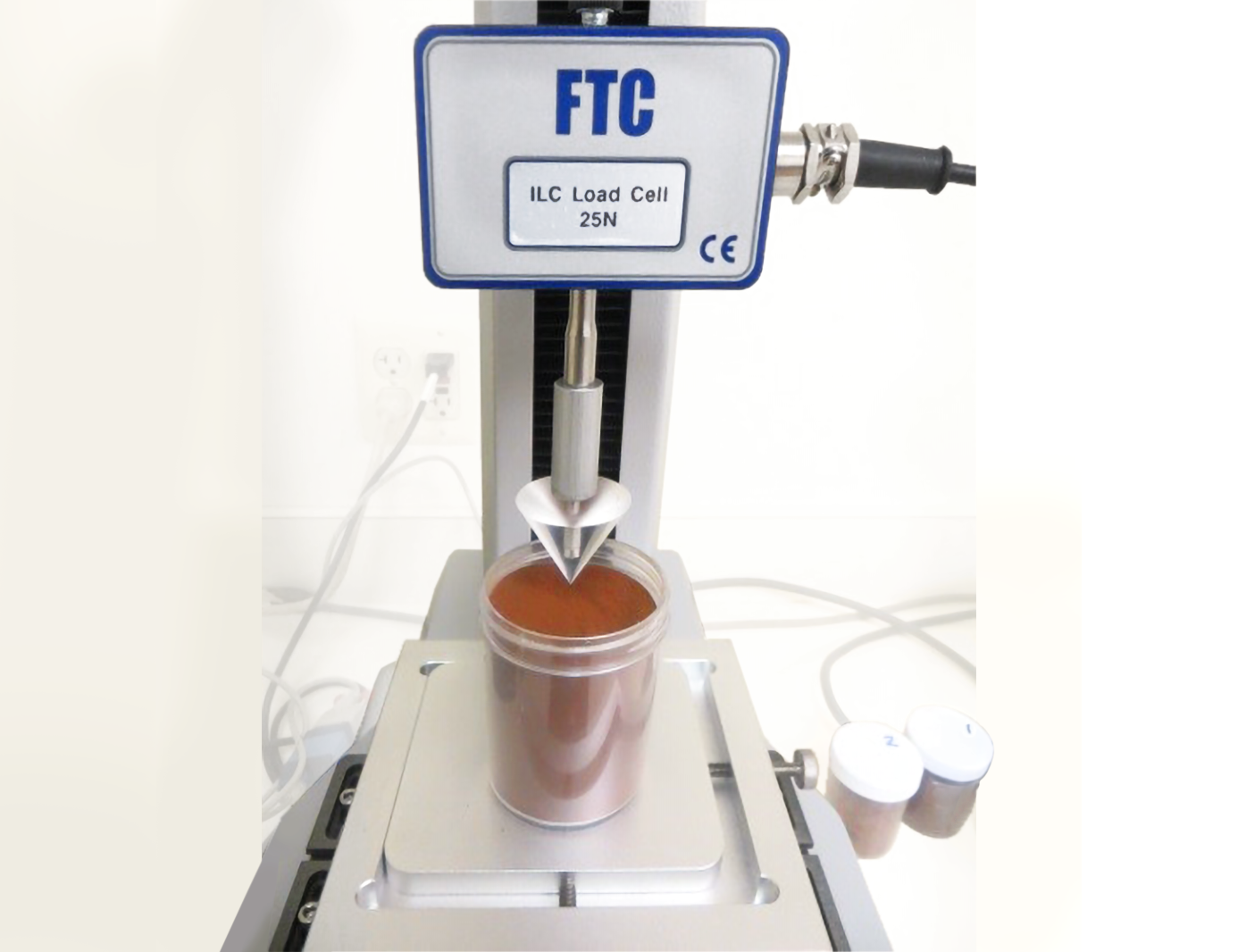Texture Analysis SolutionsPowder characterization using a cone probe
- Objective comparison to quantify the flow characteristics of powders, granules, small final products and similar specimens
- Repeatable and quick test procedure to grade the product using a software-controlled texture analyzer
- Texture analysis calculations return important physical properties with the flexibility to add further detail
- Test applicable to powders used across various industries; food, cosmetics, pharmaceuticals, industrial processing
- Interchangeable fixtures enable various test methods to be applied to define a complete property profile
Application
 While texture testing is often used to determine the quality of final products, it can also be used to characterize raw ingredients. Powder is a form that is typical of incoming raw product. For this particular application, a potential client wanted a way to differentiate between different cocoa powders using an objective method. Five samples were submitted to in order to create a methodology for this product.
While texture testing is often used to determine the quality of final products, it can also be used to characterize raw ingredients. Powder is a form that is typical of incoming raw product. For this particular application, a potential client wanted a way to differentiate between different cocoa powders using an objective method. Five samples were submitted to in order to create a methodology for this product.
By developing an objective method to characterize the incoming raw ingredient, the manufacturer will ultimately be able to have a better understanding of how these variations can affect the final product.
Problem
For this application, a method needed to be developed that would show the difference in the products submitted. As this is a powder, it behaves similarly to a liquid in that it will flow. Because of this, a test similar to a back-extrusion test was used. While the product was left placed in a container, a probe was lowered into the products; measuring the resistance that product has to movement.
The producer had specific parameters by which they graded the product, based on the peak force required to displace the powder as a probe is moved into the sample to a certain depth below the initial bed depth.
Solution
All testing was done using a software-controlled Texture Analyzer fitted with 25N loadcell. The testing probe that was use was a 60° Perspex Cone. A cone was selected as it helps to facilitate the removal of air voids as the probe moves down into the product. For each replication, the probe moved down into the product 16mm at a speed of 50mm. At the conclusion of the tests, the powders were classified as “smooth” or “lumpy” based on the shape of the graph traces. Smooth product produced a smooth and consistent graph while lumpy product had a graph that was more jagged and inconsistent.



 FDA 21 CFR Part 11
FDA 21 CFR Part 11
21 CFR Part 11 is a set of regulations from the US Food and Drug Administration (FDA) that establish requirements for the use of electronic records and signatures in place of paper records and handwritten signatures. VectorPro software, which includes standard texture calculations, implements compliant security, traceability, event logging, test versioning and other features and protocols to enable organizations to meet these requirements.
Further PFA tests
Powder flow analysis (PFA) can involve several types of test method. The powder's flow behaviour may be measured in association with cohesion, compressibility and caking. Cohesion often uses rotating blade fixtures and specialised instrumentation, whereas other attributes may be calculated with a range of compression tests. A powder bed sample may be crushed by a plunger and the resulting 'cake height' at a given force is a fundamental physical property, being influenced heavily by the internal friction of particle-to-particle interactions and moisture content. This information has important implications in manufacturing and storage situations.
Related industry products
Powders are integral to a huge range of industrial processes, contributing to a around 80% of all manufactured goods as raw materials, intermediates or final products. The cosmetics and pharmaceuticals industries include powder-based products with certain desirable textural attributes that may target free-flowing movement or more resistant, but able to be made to flow in certain situations. Final products include eye shadows, foundations and face powders, baby/body/talc powder, bath salts, body scrubs and cleansers/cleaners, foot powder, protein powder and slimming beverage mix. The widely used excipient powder ingredient, ethylcellulose (EC), is used in many industries, including pharmaceuticals, food, and cosmetics and understanding its characteristics is valuable in the same way that measuring Bloom strength provides fundamental texture information for final products that require gelling agents.

